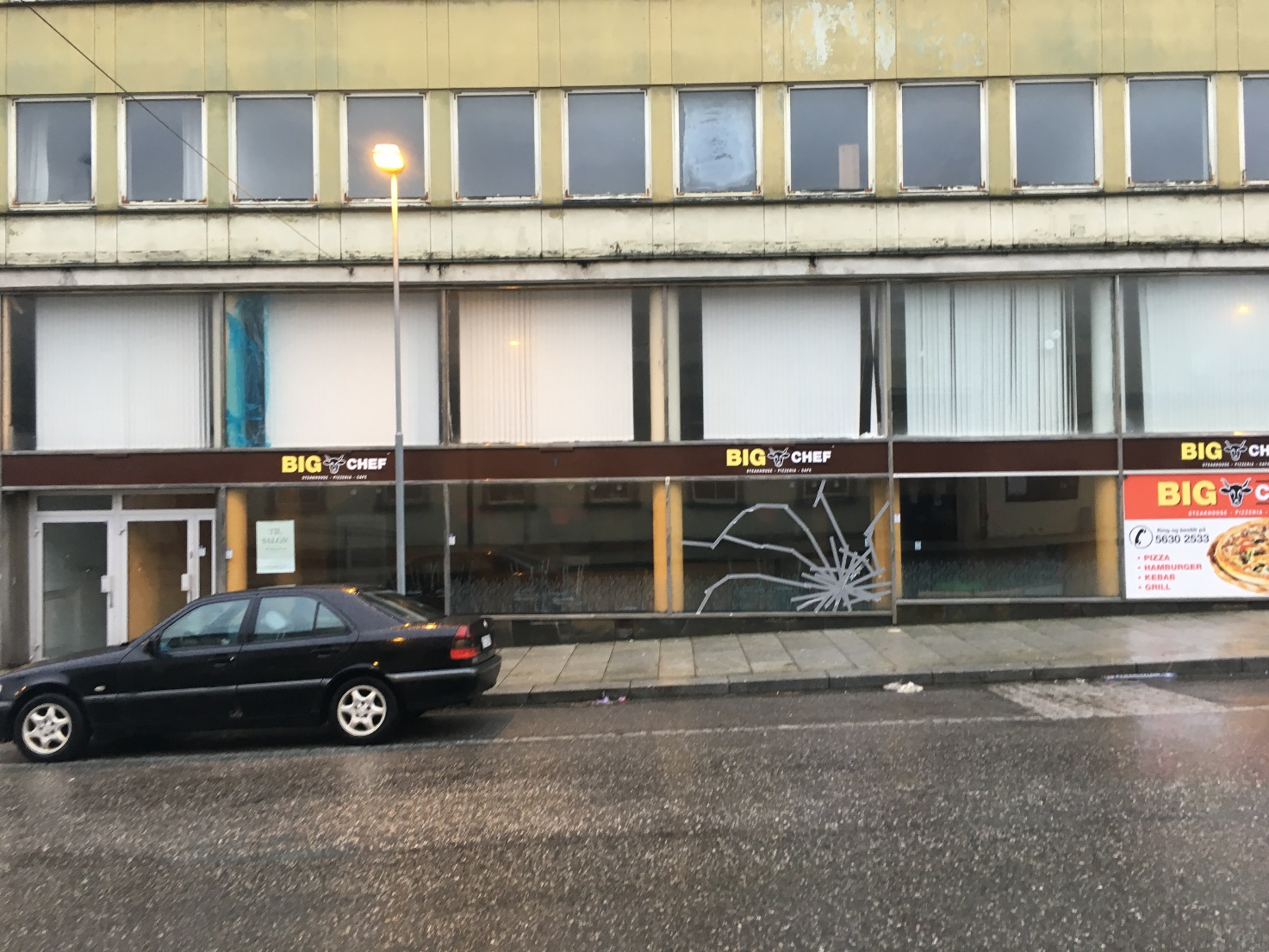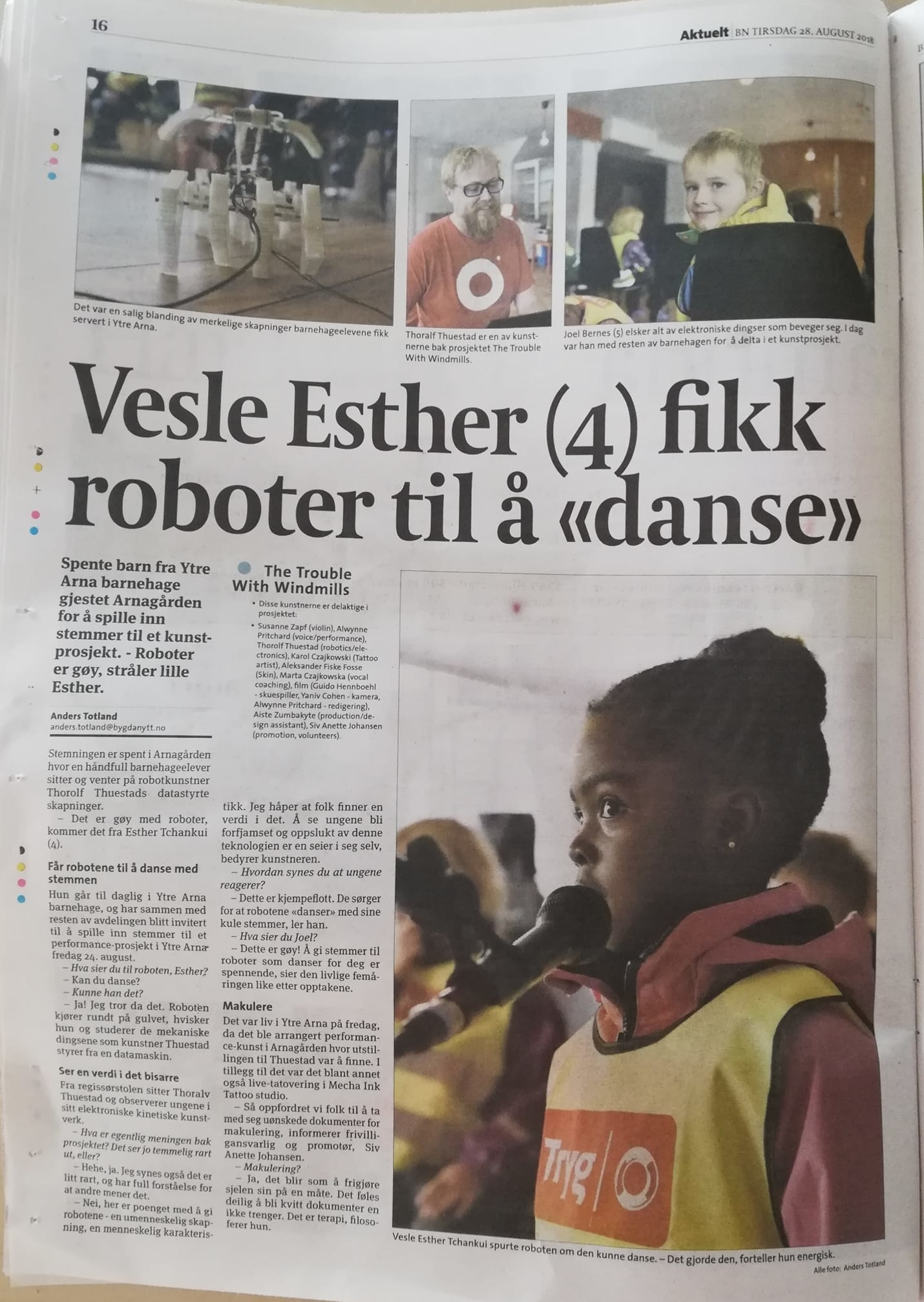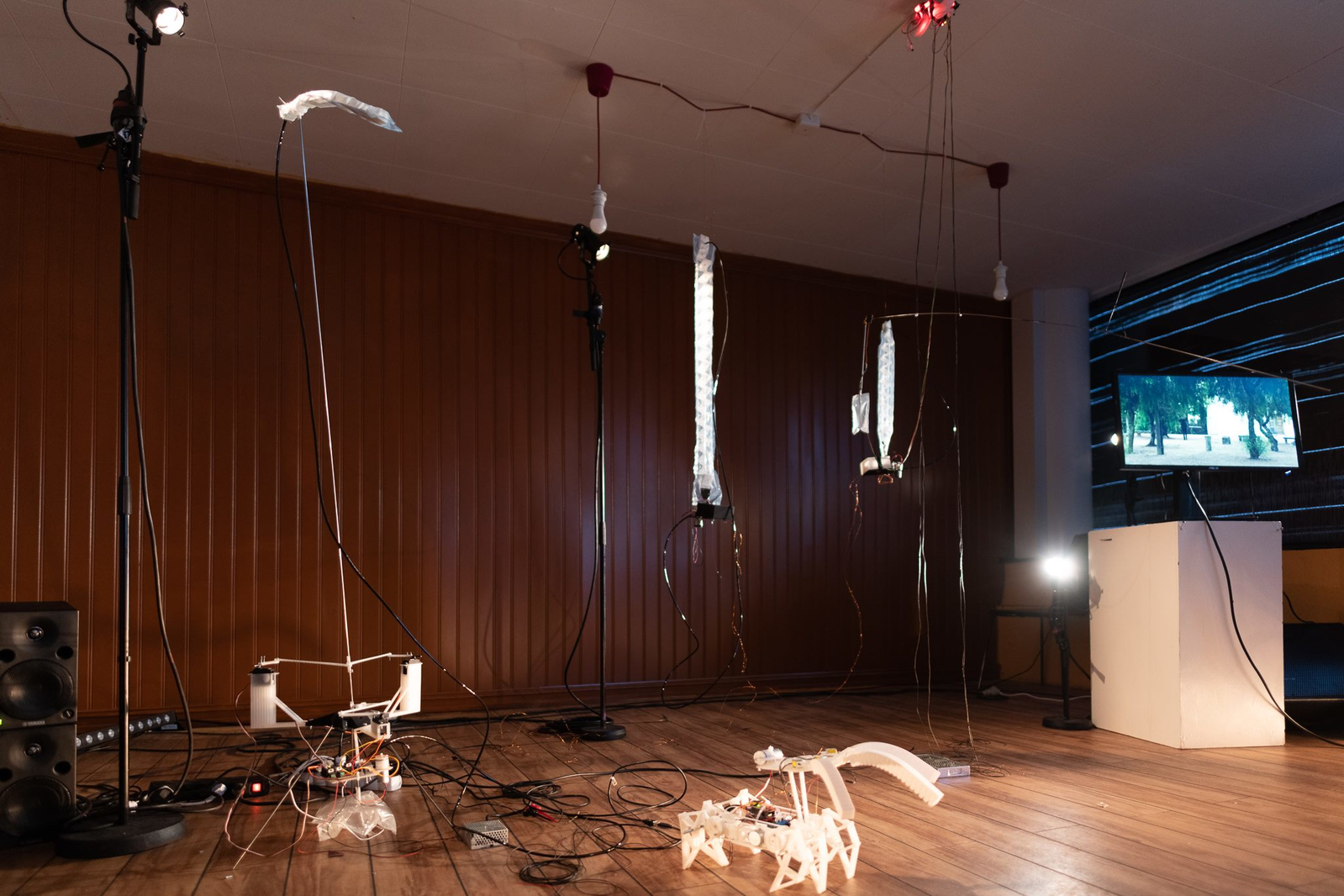My works have a sculptural side and a performative side.
I generally want a spectator to focus on the performative side.
What is it doing? is the question I would like to facilitate, not that I always accomplish this. I hear
"What is it?" quite often, and that indicates that I am doing something wrong.1
The Trouble with Windmills/Giants and Horsemen
Alwynne Pritchard and Thorolf Thuestad
Presented by Neither Nor productions
Ytre Arna 24.18.2018.
Ytre Arna is part of the Arna district of Bergen situated on the west side of Sørfjorden. It was previously considered a village but was in 2013 merged with Arna. Approximately 2700 people live in Ytre Arna. From the middle of the 19th century, the town Ytre Arna sprung up around Arne Fabrikker with Norway's first cotton-weaving machinery. Peter Jebsen founded the textile industry at the Blindheim river base, and a rapid population increase followed. The factory-built a cinema, a large community house with a theatre stage, and a church. The industry thrived, and the community grew around it. After the second world war, a gradual decline began, and by 1978 all industry was lost. The village entered a state of depression that lingers to this day.
Ytre Arna centre 2018
Ytre Arna centre is a single street that passes a chapeau, a Coop grocery shop, a specialist shop for beekeeping equipment (rarely open), an empty storefront where many eateries have been started and gone bankrupt in later years.2 There is also the culture house where musicals are performed from time to time, a cafe called Samhold with a magnificent view that is open four hours a week on Wednesdays and a tattoo parlour named Mecha Ink.
Ytre Arna is also home to Norway's oldest centre for asylum seekers in Norway that have been in operation for 32 years at the time of writing.3
It is a village that seemingly lost its confidence as the industry failed. Its reason for existing eroded, combined with many people connected to the asylum seeker centre living in a state of uncertainty and transience.
The old factory buildings now house storage facilities, with small businesses, artists and musicians gradually taking over the structures. The Oleana brand is located by the ocean side, making high-end wool clothing.
The venues
For the performance, we wanted to use some of the disused space in Ytre Arna centre. Early on, we selected two disused storefronts in the main street. From inception to the end of the project, one of the spaces had been engaged by the Mecca Ink tattoo parlour, and shortly after the performances a pizzeria and fast food restaurant opened in the other.
We contacted the proprietors and met with a welcoming attitude and free use of the two spaces as long as it didn't interfere with their regular business. Lysefjorden microbrewery situated in Arna Industrihus was also kind enough to host an after-party for us.
The production was undertaken as a week-long project to create an hour-long two-part performance. We decided to split the production between the two spaces. Alwynne Pritchard created a performance with human performers in Mecca Ink called The Trouble with Windmills and I a composition for animated kinetic figures and audio score in the abandoned, soon to be a pizza place storefront named Giants and Horsemen.
Setting
The audience was welcomed in the Mecca Inc tattoo parlour and divided into two groups. The first experienced the Trouble with Windmills in Mecca Inc, and the other group Giants and Horsemen next door. The groups then switched venues, and we would do the performance again so that all audience members experienced both.
5 animated figures took part in Giants and Horsemen. One figure took part in the performance in Mecca Ink.
Topics
The windmills part of the title refers to those mistaken for giants by Cervantes' Don Quixote and reference the manufacturing history of Ytre Arna and the industrious daily practice required for mastery of the violin.
When creating the performance I used the topic as mediation on a mindset dictating that to realize big ideas, we must submit ourselves to the task and that great projects require aspiration and hard work. Yet ultimately, they will all turn to dust. The beauty of human existence, and of places like Ytre Arna, is that life persists.
Don Quixote is the story of a man who loses his mind to fiction. Old and frail, he believes himself to be a young and gallant knight. He will fight evil with his lance. But he mistakes windmills for giants, and his battle is a farce. His enemies imagined. The lance Don Quixote eventually fashions for himself is just the branch of a tree and the giants he battles just windmills. But despite his foolishness and delusions, he is a man of tragedy and grace. He embodies some of the most compelling qualities of human aspiration and unpredictability. He shines a light on the fact that all human endeavours are dependent on a degree of self-delusion.
The performance
The performance started with a short film showing a recreation of a scene from Werner Herzog's beautiful film Land of Silence and Darkness 4 showing deaf and blind man discovering and interacting with a tree. The performance space figures gradually started moving with the trees in the screen, and the composition for audio, light, and kinetic figures began.
The composition made some limited use of theatrical light (graciously provided by Thomas Bruvik/Carte Blanche). The composition consisted of a preprogrammed sequence of movement material, improvised audio based on prepared sample material sounding together with the sounds of the electric motors, pneumatic valves of the figures and about 15 lighting cues.
Introducing the performers
Before each performance, I gave a short introduction consisting of the following requests:
I told the audience that the performers the audience could see in front of them still had no names, but they would like to have some. Could the audience help us with that and come up with fitting names for the figures? Secondly, I asked that the audience attempt to understand the figures' intention and try to imagine what it would be like to be one of them.
This was an attempt at preparing the audience to make themselves available for the experience and gently nudge them towards thoughts that could stimulate the human ability to afford affective or emotive relation towards objects.
I was inspired by a two-day seminar I had taken part in some weeks earlier with the teaching artist Eric Booth.
According to him, if there is a difference between art and entertainment, he puts it down to artworks expecting an active and investigative approach on the part of the audience. He describes the fundamental act of art as the act of world-making. For example, when introducing an audience to a piece of music, particularly of a more modern variety, the teaching artist's job would be to show people what do when they don't know what to do. When exposed to artistic expression that you may not know how to interact with, the teaching artist will establish techniques for the perceiver to connect with the artwork by linking it to some experience that is relatable on a personal level. Eric Booth has developed a framework where this is done by making connections between the observers own (private) experiences and the art offering. If introducing a musical work, he would attempt to create a state of active listening where the listener creates their own framework for reading the work based on their own experiences and knowledge.5
I formulated the questions this way as an attempt to give the audience simple tasks that would guide their minds towards experiencing the figures from a stance of encouraging the formation of relational bonds towards them, without explicitly telling them that this was a project topic.
After the two performances, and for several weeks later I was presented with suggestions for names, and a few suggestions for what the intent of the figures may be.
After the performance had taken place, I discussed framing the performance using these questions with my main supervisor Trond Lossius. He pointed out that the formulating the questions like I had, even if the motivation was to open avenues allowing a sense of relation between figures and the personal experiences of the audience, the suggestive and quite specific nature of the questions also closed down other avenues that might have been available to audience members had the questions not been asked. In other words, my attempt at guiding the reading of the work may have caused the audience to turn a blind eye to other possible openings forming relations towards the figures.
I asked a few of the audience members whether the questions affected how they experienced the work:
«Yes, I think so. I was looking for human characteristics in the figures more than I otherwise would have»
Eva Pfizenmaier6
"I am all for guiding the audience as much as possible, however, with content like this that is open for personal interpretations it is in a sense a pity to deny the audience the full potential scope of experience»
Peter Voss-knude.
Another audience member told me that he had determined that the figures’ intention was to breathe, and that watching them struggling with that task made him feel like he was suffocating.
Famous experiments by Daniel Simons and Christopher Chabris have investigated the cognitive phenomenon of selective attention. In the famous invisible gorilla experiments (1999)7 viewers of a video showing two teams of players passing a basketball are asked to count the number of passes of the team wearing white. If not familiar with the experiment, half the viewers completely miss a person in a gorilla suit walks into the middle of the screen and pounding its chest as the basketball is passed around. The viewer is focused on counting the passes to such a degree that the rest of the world fades into perceptual invisibility. Simons and Chabris conducted multiple follow up experiments where multiple even more radical changes would occur in the videos with the same result. It seems that human attention is also human obliviousness.
Could my attempts at directing the audience’s perception have caused similar perceptual blind spots?
The children of Ytre Arna kindergarten
The day before the shows, I was able to receive the lovely children from Ytre Arna kindergarten. The kids were 4 – 6 years old. Initially, my intention was to show the figures to them and observe how children interacted with them while getting the kids to give "voice" to the figures.
I had prepared software and a technical setup that allowed the children to speak into a microphone with the software converting their voice to text. If any words matched any of a list of keywords, one or more of the figures would move. The keywords were things like «left», «right», «move», «forward», «back», «walk», «hello», «name» and so on. The movement would roughly correspond to the words. «Left» would, for instance, make figure #3, «The Drunken Tongue», tilt to the left. As the child spoke into the microphone, their voice was sampled, and a processed version played back as the figure moved in effect using the child's voice as the voice of the figure.
As it turns out, this worked only moderately well. When receiving the kids, I did not give them any instruction other than to talk to the figures using the microphone. I had assumed that they would ask them move in some way or another, but in retrospect realize that nothing was indicating that the strange figures in front of them were there to move.
Expecting to be able to predict how the children would interact with the figures was folly. One child started telling the machines about her day, another asked the figures what he should say, almost all told the machines their names but never asked what the name of the figures where. As a result, almost none of the keywords in the list where actually spoken and the few times when it occurred the causality between the words and movement was not apparent to the children.
It became clear quite early in the session that the children were not likely to say many or any of the keywords, I had prepared. I started manually triggering some of the preprogrammed movement trajectories to respond to the children talking to the machines. By chance, I started doing this the same time as one child asked the machines «to dance», a word that was not in the list of keywords (though it probably should have been). When this command then resulted in movement, «dance» was subsequently repeated by every child. At this point, I thought it would be apparent that I was triggering the movements manually, but the kids either did not perceive a connection between me having taken up position at the controlling computer at the back and loudly clicking buttons as they spoke causing the movements of the figures, or they simply did not care.
If they were aware, that did not seem to affect the willingness and determination of the children to perceive the objects as having agency, as can be seen in the dubious expression on Esther's face:8
As the session progressed, it became difficult for me to keep up with the children triggering the audio samples and movements. Seemingly heartfelt frustration would be expressed by the children when the robots didn't immediately do anything as a response to their requests.
After a while, I started playback of a segment of pre-arranged movements so that the figures would move by themselves. For the children, this on a generally seemed to be much less engaging. The highest level of excitement was expressed when they perceived there being communication between themselves and the machines.
Experiences
My estimation of which keywords would match what the children were going to say to the figures was clearly off, and the session as a whole became more makeshift. Despite this, the experience surprised me with the intensity of the emotive investment. It was very clear to me that the children had a strong urge to experience some form of communication between themselves and the figures.
I don’t think this investment on the part of the children was caused by the “magic of technology”. It is safe to assume that these children are regularly surrounded and exposed to various machines and technology in their daily lives, devices whose principles of operation are hidden to them. Yet believing that there was communication between themselves and the figures, that the figures in effect had agency and intent, seemed to be preferred over the more apparent(to me) explanation of me operating them directly.




